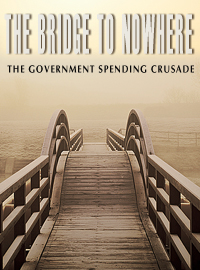| Budget Cuts Can Be Political Winners |
 |
|
By Quin Hillyer
Tuesday, December 04 2012 |
For decades now, Republicans have championed the vague idea of budget savings while fearfully shying away from efforts to “sell” the cuts as anything other than a necessary discipline. Their lack of courage and creativity is pathetic. In “fiscal cliff” negotiations and in all similar budgetary imbroglios in the next few years, fiscal conservatives should highlight specific cuts not begrudgingly, but as if the cuts themselves are gifts to their constituents. The model for this approach was the fight over the “Bridge to Nowhere.” Put a clever title on something, keep it simple, and, voila, a cut in government spending becomes a popular crusade. The fact is, the federal government is full of spending on programs so absurd as to invite absolute public scorn. Rain forest laboratories in the Farm Belt. Experiments involving shooting cats in the head to re-prove medical findings first announced in the 19th Century. All sorts of narrow-interest museums in decidedly odd places. For years, U.S. Senator Tom Coburn (R-Okla.) has helped publicize items from a “Pig Book,” drawing attention to ridiculous government excesses. His Wisconsin Republican colleague, Ron Johnson, likewise has identified huge savings via sensible efficiencies in federal pay and benefits. A bit of bureaucrat-bashing, when it comes to retirement benefits 14 times more generous than in the private sector, can prove to be a decidedly populist message. Fiscal conservatives should cherry-pick all the least defensible spending items and package them with a great big (figurative) ribbon, with a full-court public relations press (sorry for the mixed metaphors). For the first set of savings, it ought to be relatively easy to find items whose elimination (or serious reduction) would not only cause no public backlash, but would actually be celebrated by clear majorities. Tens of billions of dollars of domestic discretionary spending probably meets this criterion. Way back in 1995 and 1996, appropriators cut a total of $50 billion in actual spending – not projected increases, but actual dollars – and eliminated 300 programs completely, while liberals found very little fodder for successful demagoguery against them. (This was when $50 billion was a vastly larger proportion of the discretionary budget than it is now, making it a more significant cut then than, say, $80 billion in two years would be today.) The Clinton White House and Democratic allies on Capitol Hill kept trying and failing to scare the public about those cuts, but it was only when Speaker Newt Gingrich agreed to tether them to Medicare savings that the Clintonite scare tactics gained serious traction. Even then, though, the communications effort in support of the cuts was not handled particularly cleverly or systematically, much less strategically. (I know whereof I speak: I was a press secretary for the House Appropriations Committee then, but I failed to break through the fog of an overwhelmed House leadership bureaucracy. Result: We were usually flying by the seat of our pants.) Yet despite it all, the Washington Post’s Glenn Kessler correctly recalled in 2011 that “Gingrich and his Republicans had actually achieved a great victory by the end of the first shutdown. …[T]he irony is that if Republicans had quit while they were ahead, compromising on some issues, they -- and not Clinton -- would have won the credit for the balanced budget that emerged within years. ...” Again, those cuts weren’t even packaged especially well. Yet they enjoyed more public support than not. Imagine how much more support would accrue for savings packaged as creatively as the “Bridge to Nowhere” repeal. With savings as a political boon rather than as the mark of a collection of Scrooges, all sorts of negotiating possibilities suddenly could emerge for fiscal conservatives who right now are feeling cornered. The House, for instance, could pass two bills to ward off the (poorly named) fiscal cliff. The first would extend the Bush-era upper-income tax cuts along with perhaps the expanded per-child tax credit also at risk of expiring – but coupled with the closing of a some upper-income loopholes and deductions and with the easiest, most popular of spending cuts to make it revenue-neutral. The second bill would couple the extension of the so-called “middle-class tax cuts” and repeal of, say, ObamaCare’s medical device tax with some of the harder discretionary savings and some of the easiest of entitlement reforms, such as raising the eligibility age for Medicare for those now under, say, age 35. That’s just a proximate example of the best approach, cobbled together in just 15 minutes of mental math and “strategery.” The point is that if some savings are well marketed as a political plus rather than as castor oil, the strategic and tactical options for conservatives expand significantly. Done like this, budget negotiations could become a bridge to somewhere much better, with President Obama left on a political island by his lonesome. |
Related Articles : |
























